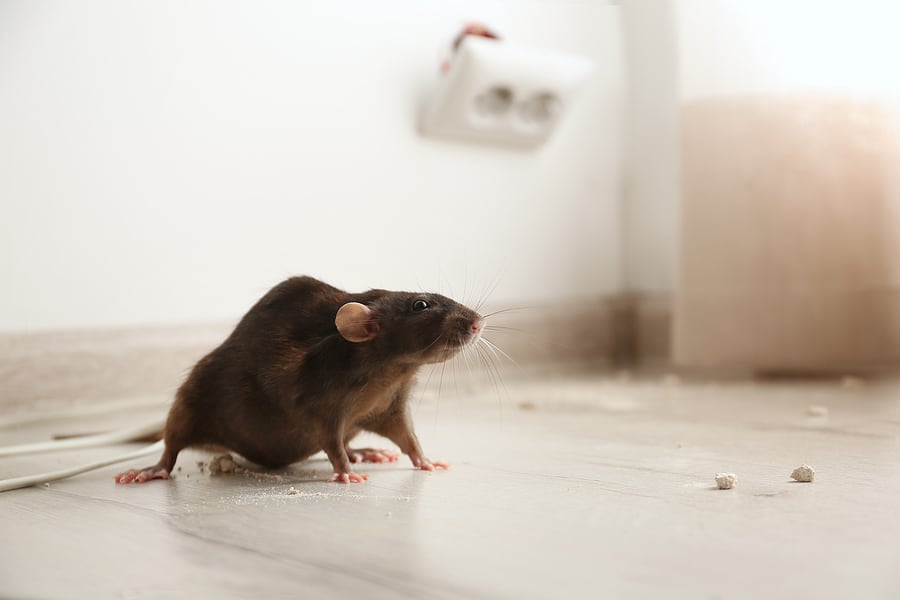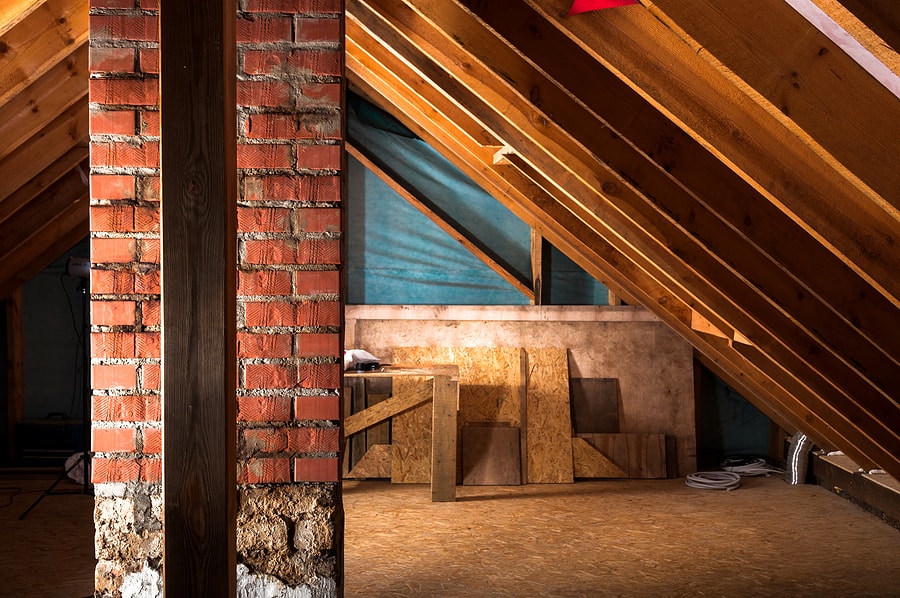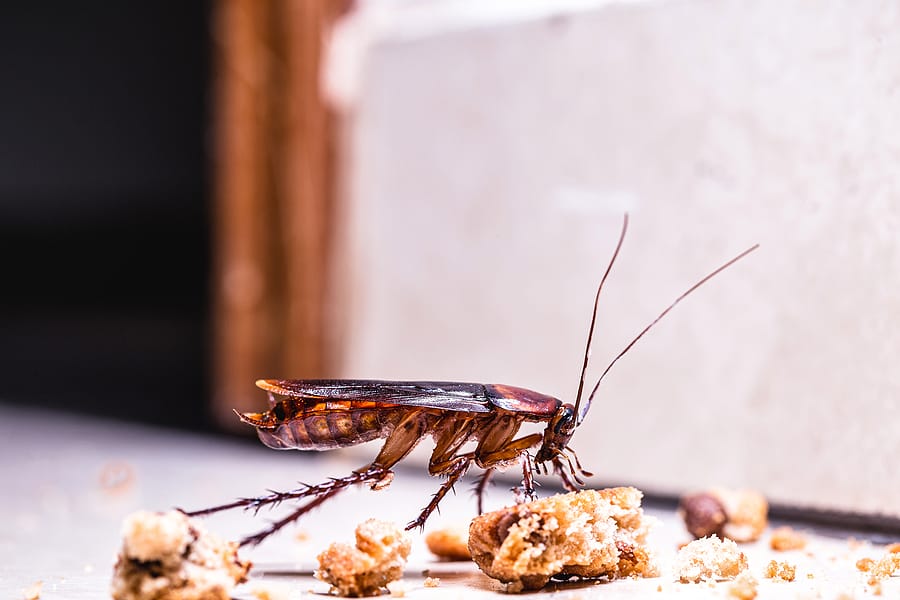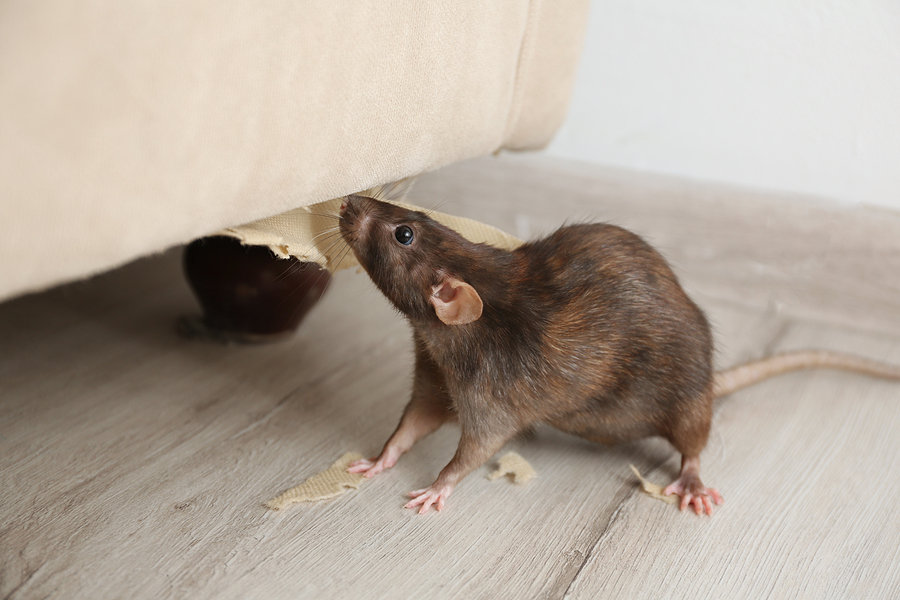READY TO GET STARTED?
REQUEST A FREE ESTIMATE
Fill out the form below or call (888) 466-7849 for a free, no-obligation estimate.

Rodents are one of the most resourceful pests when it comes to getting into your home. Mice and rats can squeeze through the tiniest cracks to gain access and they require very little space to travel inside. Rodents seek shelter indoors, especially during the fall and winter months as they go in search of warmth, food and water. While a rodent sighting can be scary enough, these pests also pose serious hazards to your home and your health. They can gnaw through cardboard, paper, and even electrical wires, putting you at risk for fires. They are known to carry bacteria, like salmonella and hantavirus, and can contaminate your food, kitchen surfaces, and other areas of your home. Even rodent droppings are dangerous – helping spread these pathogens to you and your family.
The first step in rodent control in and around your home is to prevent them from getting inside in the first place. Here are 10 easy tips you can use for preventing mice and rats:
If you do find signs of rodents in your home, best practice is to remove them and prevent re-entry as soon as possible. This is best accomplished by a professional pest control company who can not only eliminate the nuisance pests, but help identify nesting sites and points of entry to help prevent reinfestation in the future.
Don’t Forget the Forgotten Rooms
Avoiding A Winter Wildlife Invasion
9 Energy Saving Tips For Winter

Main living areas such as kitchens, bathrooms, and bedrooms are all places that homeowners want to ensure are pest-free and wildlife-free year-round. While these spaces are always important to keep free of pests, it’s equally important to prevent them from entering the “forgotten rooms” in your home, as well. These forgotten areas include your basement, attic, and even extra storage rooms. Unfortunately, many homeowners are so focused on keeping the main living areas pest-free that they sometimes forget these other areas too.
Wildlife critters and household pests are looking for three things: water, food, and a warm environment. These three elements are easily available inside every home. Your attic is the perfect room for wildlife to make their home and for a pest to infest. Wildlife such as raccoons, squirrels, and birds can make their way through any openings or gaps leading into the attic. Sealing up any entry points is always a great start for wildlife prevention. Check your attic for any holes or gaps and seal them up immediately. In addition, inspecting your attic insulation is key to household pest prevention. Proper attic insulation can help prevent bugs such as roaches or ants from making their way inside.
Basements will often contain moisture by way of standing water, which provides pests and wildlife a plentiful water supply. Water is one of the main sources of attraction for pests like termites and millipedes. Cutting down moisture is essential to pest prevention. A moisture barrier for your crawlspace and a gutter protection system for your roof are great investments to help eliminate any standing water. These investments both help ensure that water is not filtering into your crawlspace and basement area.
If you suspect that you have a pest or wildlife infestation in your home’s “forgotten areas,” consider reaching out to your local pest control company. A professional will inspect these areas and provide you with a prevention and treatment plan.

During the wintertime, many homeowners worry less about pests that are common during the spring and summer months. Contrary to popular belief, however, some pests don’t just die off; instead they use their survival instincts to get through the winter. Here is a list of four common winter pests and what you can do to prevent them once the warmer weather arrives!
Seeing ants marching inside your home is typically uncommon during the winter months. Ants are still around, however, as they are great at overwintering and preparing for the cold! Ants prepare for the colder weather starting in the fall where they indulge in lots of food. This preparation technique helps them put on fat so they can survive for weeks at a time without eating. When winter finally arrives, their body temperature and activity will decrease. They will then seal up their colonies built deep in the soil or under rocks, where they will stay until springtime arrives!
Once the warmer weather hits, ants are full of energy and ready to invade your home in search of more food. To make sure these pests don’t come inside, seal all open gaps and holes, especially around areas where pipes and wires enter your home.
Bed bugs are active year-round, meaning they will invade your home whether it’s cold or warm outside. These pests are extremely resilient and can survive temperatures from nearly freezing to 122 degrees Fahrenheit! Because they can withstand these extreme temperatures, bed bug control can be difficult. Common signs of bed bugs include rusty, reddish-brown stains on bed sheets or mattresses, bites on exposed skin when sleeping, and eggs or egg casings.
After coming home from traveling, unpack your clothes and put them directly into your washing machine to clean. Always inspect your luggage for bed bugs and use a vacuum to clean it before storing it.
Most cockroaches can survive year-round if they have access to a warm and moist environment. Unfortunately, this means your home is the perfect place for these pests to inhabit. German cockroaches are one species that are known to survive harsh weather conditions. When cold hits, these roaches are great at sneaking indoors through small gaps and holes.
Cockroaches prefer to live in humid habitats, especially in residential kitchens, bathrooms, and basements. To ensure these pests don’t infest your home, make sure to clean up any spills or food crumbs, vacuum often, and use weatherstripping to seal doorways.
It’s inevitable to see mosquitoes out during the summer months; but it may be surprising to most that these pests don’t die off when winter hits. Mosquitoes will, instead, overwinter or hibernate in protected areas such as hollow logs. When the temperatures increase, female mosquitoes will awaken and seek out a blood source to feed on to begin developing eggs.
Preparing for mosquito activity before summer arrives is crucial in protecting your home and family. Confirm your home is mosquito-proofed by eliminating any standing water, debris from your gutters, and sealing any holes or gaps leading inside the home.
To prevent these pests from invading your home when spring and summer hit, consider contacting your local pest control company. A trained professional can then provide you with an inspection, prevention, and treatment plan.

Pest control starts at home. By establishing a good line of defense on the home front, you’re less likely to need to mount an offense against those pesky pest invaders. Prevention is key to keeping a small pest problem from becoming a full fledged pest invasion. Here is our guide to home pest control:
The fewer pests you have outside your home means less of a chance they will make their way inside your home. Make your yard less hospitable for pests to reduce the likelihood they will move indoors. Keep tree branches and shrubbery trimmed back so they don’t touch your house. This helps eliminate “bridges” they can use to get inside. Mulch is also excellent for sheltering unwanted pests. Consider using a cover that is less attractive like rock. Clean out leaves and other debris from gutters or install gutter guards to help prevent standing water.
The best way to keep pests out is to find out how they can get in and eliminate these points of entry. Routinely inspect the entire exterior of your home for gaps, cracks, and crevices. Check foundations, loose siding, missing shingles, and gaps around utility lines (especially pipes, wiring, and cable). Seal any openings you find with either copper mesh, steel wool, sheet metal or mortar. Try not to use expanding caulk because some pests can still chew through this (think rodents!). Keep an eye out for signs of termites including mud tubes, damaged wood, or cracked and bubbling paint. Repair fascia and rotted roof shingles. Replace weather stripping and make sure to repair loose mortar. Use screens on windows, attic vents, and chimney openings.
Bugs tend to be more attracted to standard mercury vapor lightbulbs. Consider replacing your standard lightbulbs with high pressure sodium vapor or halogen bulbs instead. What the bulbs are made of aren’t the only thing you should consider. Check the color of the lightbulbs, as well. Bulbs with pink, yellow, and orange tints are less attractive to pests.
Garbage attracts pests like rodents, roaches, and even ants. These pests are also attracted to yard waste which can provide them with both a source of food and a nesting site. Use garbage and recycling cans with tight-fitting lids. Make sure to clean both the garbage cans and the area where they sit on a regular basis. Clean up any spills and leftover debris that these pests can feed on. Keep your deck, patio, garage, and yard clear of leaf litter, clippings, and standing water. Rinse all the food off anything you are recycling before putting them in the bin. Store your cans outside whenever possible.
Inspections shouldn’t be limited to outside the home. The interior needs to be inspected regularly, as well. While inspecting, make sure to look under, inside, and behind cabinets, the refrigerator, and the stove for signs of household pests. Look for gaps around pipes, vents, and cables and in the trim. If you find any gaps, seal them up, especially if they are 1/4″ in size or bigger. Check for moisture under sinks and repair leaky pipes, Use a dehumidifier in crawlspaces, attics, and basements.
Drains in the sink, tub, shower, and floor can hold moisture and accumulate debris and gunk. This not only attracts pests but also provides them with the ideal environment to breed in. Inspect and clean all your drains on a regular basis, including those in the laundry room and basement.
Establishing a regular cleaning routine helps keep your home clean, making it less attractive to pests. Keep food stored in containers with tight fitting lids or resealable bags. Never leave open food out overnight. Keep the pantry cleaned out regularly to get rid of spoiled food and other items. These steps will help eliminate pantry pests. Wipe down countertops daily and keep ripe fruit in the fridge. Wash dishes or load the dishwasher nightly and don’t leave dirty dishes in the sink overnight. Sweep, vacuum, and mop on a regular basis, as well. This not only disturbs the areas that pests may frequent but also helps eliminate crumbs and debris that can serve as a food source.
Pets aren’t immune to pest problems. Not only can pests hitch a ride inside on your pets, but their food and water also serve as attractants. Keep your pet’s food and water bowls clean and clean up any spilled food and water immediately. Launder your pet’s bedding in hot water every week. Store pet food in a sealable container. Per your vet’s recommendations, use appropriate flea and tick prevention as needed.
A small pest problem can escalate quickly; but with this handy guide to home pest control, you can take the necessary steps to prevent a pest infestation. If your pest problem has gotten out of control or you want a little extra help from a pro, contact a professional pest control company for a complete inspection and treatment plan.

One thing that is sure to put a damper on your holiday spirit is unwanted pests! The holiday season provides ample opportunity for household pests to make their way into your home. Spiders, rodents, ants, ticks, and other overwintering pests will commonly invade in search of food, water, and shelter.
Holiday pests will use Christmas trees, wreaths, firewood, decorations, storage boxes, luggage, and more to hitch a ride into your home. Some pests will hide in the branches and crevices of Christmas trees, wreaths, garland, and firewood. They can even lay eggs which will then hatch after you bring them inside. Mice and other pests will take refuge inside your storage boxes that hold decorations. You may find live pests, dead pests, or droppings inside these containers. You may also find that they have chewed or damaged wires inside the box.
Increased travel at the holidays increases the risk of bed bugs. These pests hitch a ride on unsuspecting travelers’ luggage, coats, purses, and more. The kitchen is often the central gathering place for holiday cooking and meals. It can also be a big source of food for unwanted pests. Crumbs, spills, leftovers, and dirty dishes all provide an easy food source for holiday pests.
Don’t let pests ruin your holiday plans. Keep them away with these 5 holiday pest control tips.
Pests can come indoors on live trees, wreaths, garland, and firewood. Carefully inspect these items outside before bringing them inside. Make sure to check for live pests, nests, and eggs. Shake them out carefully to disturb any slumbering pests and to knock off any hidden pests.
Pests will hide out in boxes used to store decorations and other holiday items. Unpack these items outside and inspect them all carefully for signs or pests including dead bugs, live bugs, droppings, gnaw marks, and other damage. Carefully check strings of lights and other wires for signs of chewing.
Holiday meals are centered around the kitchen. Clean up the kitchen after cooking. Wash dishes or load the dishwasher and don’t leave dirty dishes out overnight. Sweep up any crumbs from the floor and clean up spills immediately. Make sure to empty the trashcan frequently, especially before bedtime.
Bed bugs are common at the holidays because of the increase in travel. Whether you are going away or you have guests coming in, inspect the bedding carefully for bed bugs. Signs of bed bugs include live bugs, reddish brown spots on bed linens, and shed skins. These can be found on beds, mattresses, box springs, linens, curtains, furniture, and even baseboards. Check luggage before bringing it into the house. Wash clothes in hot water and dry on hot heat as soon as you return home.
At the end of the holidays, taking down decorations and storing them for next year becomes a priority. Store your holiday decor in plastic storage bins with sealing lids rather than cardboard boxes or bags. Don’t pile discarded trees, garlands, or cut firewood near your home as these can attract termites and rodents.
The holiday season is a time of great joy, family, and friendship. Don’t let holiday pests ruin your year. If you have a problem with any type of critter in your home, contact your local pest control company for a free inspection and comprehensive treatment plan.
Crawlspace Enclosure: The Cure For Cold Feet